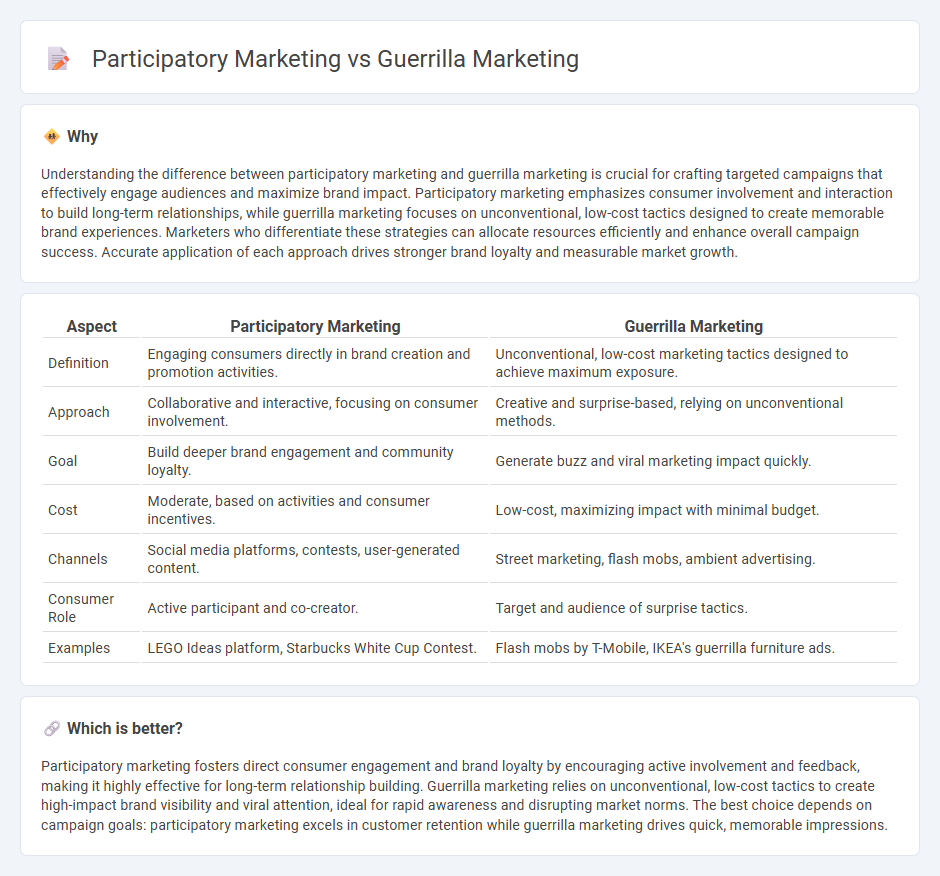
Participatory marketing emphasizes active consumer engagement by involving audiences directly in brand campaigns, fostering community and loyalty through interactive experiences. Guerrilla marketing leverages unconventional, creative tactics in public spaces to capture attention and create memorable brand impressions with minimal budgets. Explore these innovative marketing strategies to discover how they can elevate your brand's impact and reach.
Why it is important
Understanding the difference between participatory marketing and guerrilla marketing is crucial for crafting targeted campaigns that effectively engage audiences and maximize brand impact. Participatory marketing emphasizes consumer involvement and interaction to build long-term relationships, while guerrilla marketing focuses on unconventional, low-cost tactics designed to create memorable brand experiences. Marketers who differentiate these strategies can allocate resources efficiently and enhance overall campaign success. Accurate application of each approach drives stronger brand loyalty and measurable market growth.
Comparison Table
| Aspect | Participatory Marketing | Guerrilla Marketing |
|---|---|---|
| Definition | Engaging consumers directly in brand creation and promotion activities. | Unconventional, low-cost marketing tactics designed to achieve maximum exposure. |
| Approach | Collaborative and interactive, focusing on consumer involvement. | Creative and surprise-based, relying on unconventional methods. |
| Goal | Build deeper brand engagement and community loyalty. | Generate buzz and viral marketing impact quickly. |
| Cost | Moderate, based on activities and consumer incentives. | Low-cost, maximizing impact with minimal budget. |
| Channels | Social media platforms, contests, user-generated content. | Street marketing, flash mobs, ambient advertising. |
| Consumer Role | Active participant and co-creator. | Target and audience of surprise tactics. |
| Examples | LEGO Ideas platform, Starbucks White Cup Contest. | Flash mobs by T-Mobile, IKEA's guerrilla furniture ads. |
Which is better?
Participatory marketing fosters direct consumer engagement and brand loyalty by encouraging active involvement and feedback, making it highly effective for long-term relationship building. Guerrilla marketing relies on unconventional, low-cost tactics to create high-impact brand visibility and viral attention, ideal for rapid awareness and disrupting market norms. The best choice depends on campaign goals: participatory marketing excels in customer retention while guerrilla marketing drives quick, memorable impressions.
Connection
Participatory marketing and guerrilla marketing converge through their emphasis on direct consumer engagement and unconventional strategies to enhance brand visibility. Both methods leverage active audience involvement to create memorable experiences that foster emotional connections and viral sharing. This synergy enables brands to maximize impact with cost-effective, grassroots-level campaigns that drive authentic customer interaction and loyalty.
Key Terms
Guerrilla Marketing:
Guerrilla marketing leverages unconventional, low-cost tactics to create high-impact brand exposure and memorable consumer experiences through surprise elements and creative street-level engagements. This approach maximizes limited budgets by targeting specific urban locations or events to generate word-of-mouth buzz and viral social media content. Discover how guerrilla marketing strategies can transform your brand visibility and consumer interaction.
Ambush Tactics
Guerrilla marketing utilizes ambush tactics by surprising audiences with unconventional, low-cost campaigns that create buzz in public spaces without prior notice. Participatory marketing engages consumers directly, encouraging them to co-create content or experiences, often blurring the line between audience and advertiser through interactive ambush approaches. Explore the nuances of these ambush tactics to understand their impact on consumer engagement and brand visibility.
Unconventional Promotion
Guerrilla marketing leverages unconventional promotion tactics to create high-impact, low-cost campaigns that capture audience attention through surprise and creativity in public spaces. Participatory marketing emphasizes consumer engagement, encouraging audiences to actively contribute content and ideas, fostering a sense of community and brand loyalty. Explore the distinctive strategies of each approach to enhance your brand's promotional effectiveness.
Source and External Links
Guerrilla marketing - Wikipedia - Guerrilla marketing is an advertising strategy that uses surprise and unconventional interactions to promote products, aiming to create emotional reactions and memorable experiences with low cost but high engagement.
What Is Guerrilla Marketing? 4 Types and Examples to Delight ... - Coursera - Guerrilla marketing creatively disrupts public spaces with surprising, inventive tactics to attract customers and create big impact on small budgets, relying heavily on human interaction and social sharing.
Guerrilla Marketing: understand what it is and how to do it - Salesforce - Guerrilla marketing captivates audiences with unexpected, creative approaches that boost engagement, expand brand reach through viral potential, and deliver high impact at low cost compared to traditional advertising.
 dowidth.com
dowidth.com